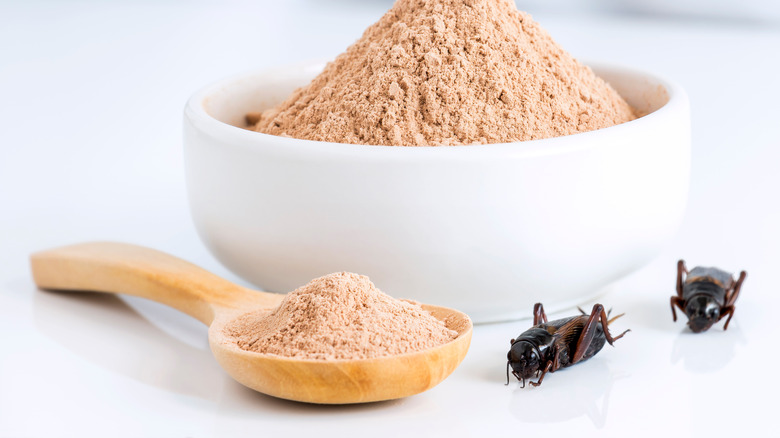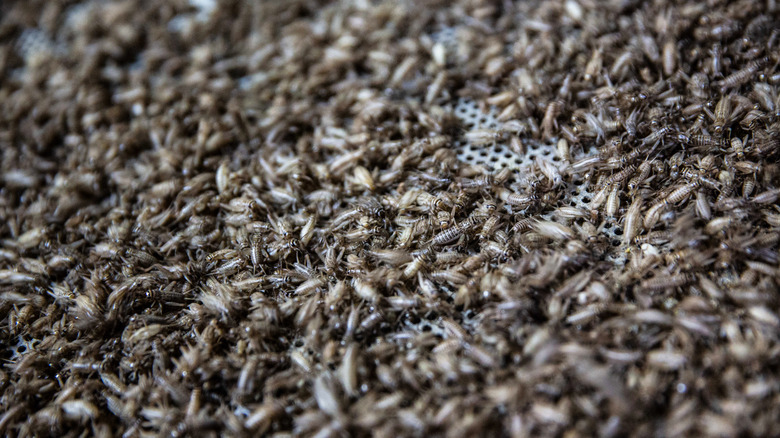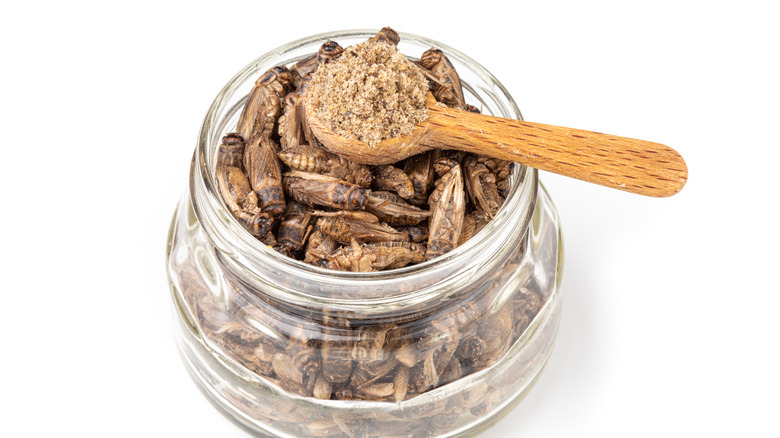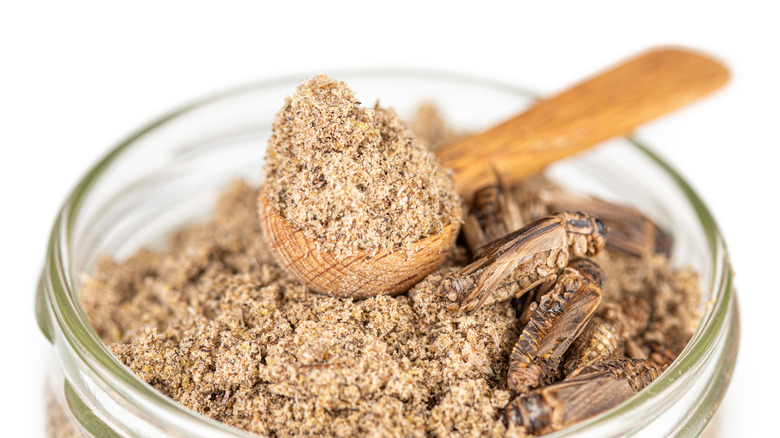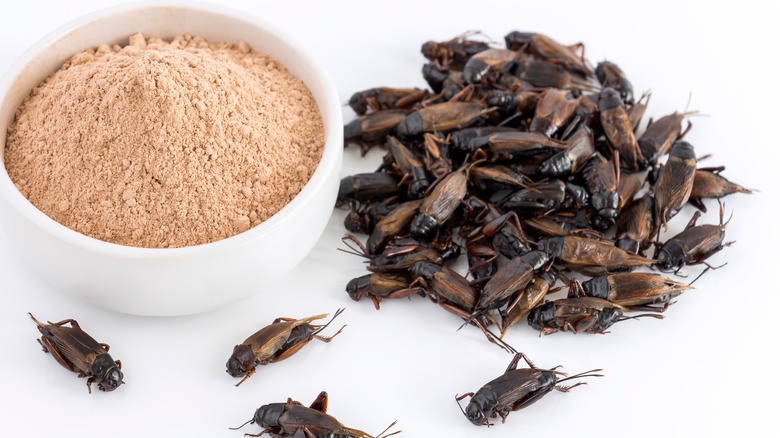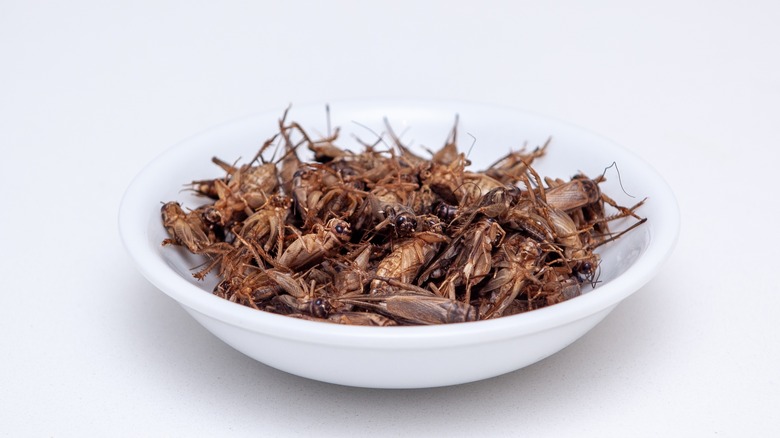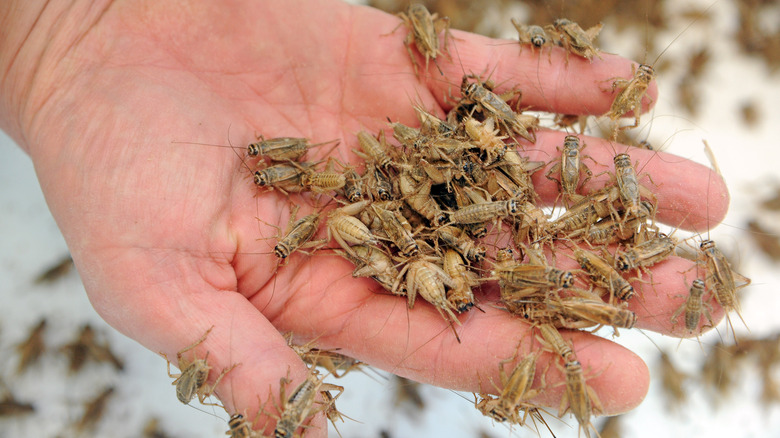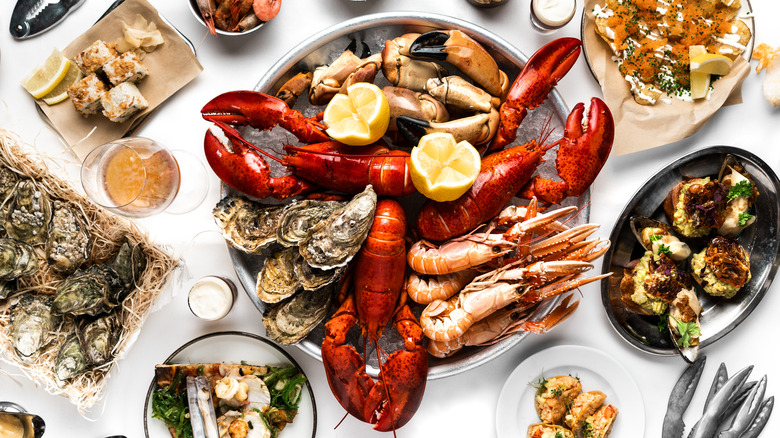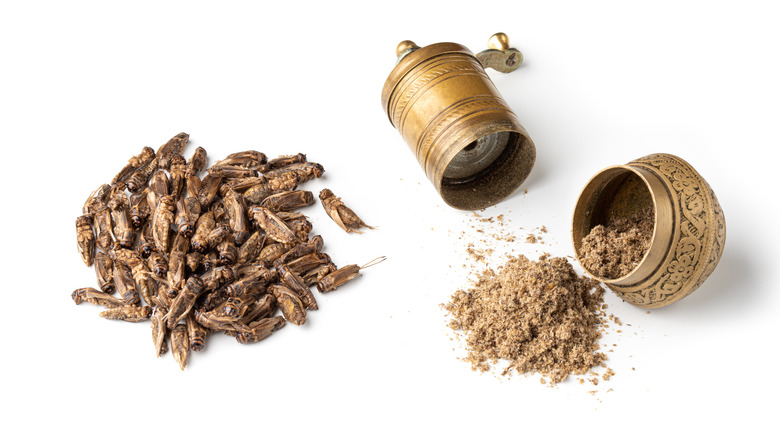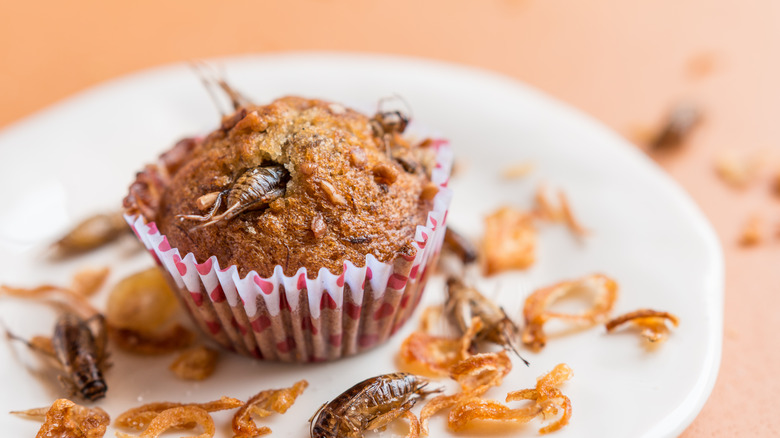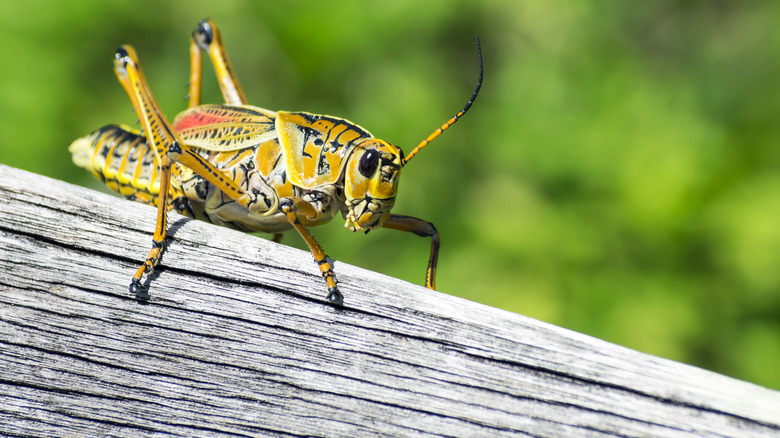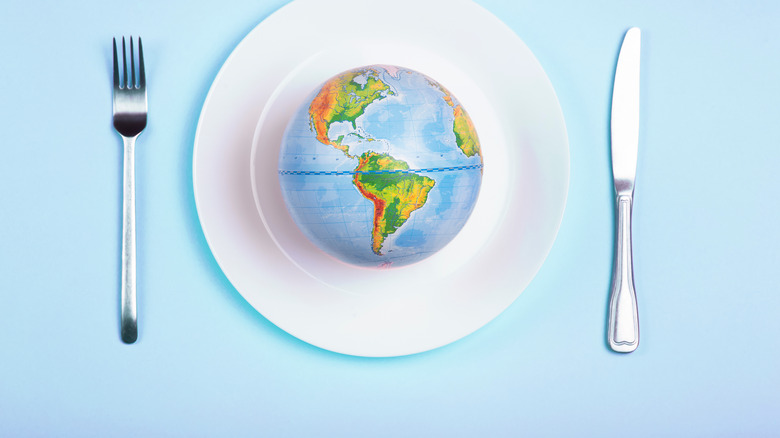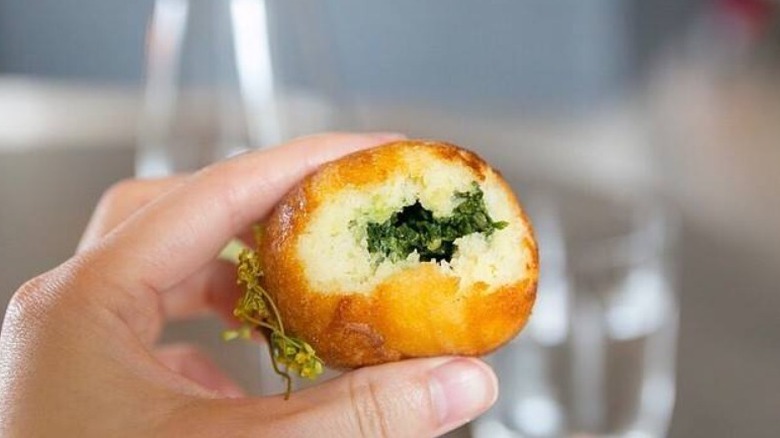The Untold Truth Of Cricket Flour
For some, the idea of eating crickets — and really any insect — is definitely not an option. Pests and creepy crawlies often feel like they're off-limits in terms of the dinner table. But, if you come across cricket flour, you shouldn't say "never" just yet. First of all, cricket flour is broken down and processed, so you will not actually have to crunch through the exoskeleton with your teeth. Instead, you just mix the flour into whatever else you're making and get on with your day.
Eating crickets has several health benefits. According to Dr. Axe, cricket flour is a good source of B12 and amino acids. Additionally, eating crickets is highly beneficial for the world at large as crickets require significantly fewer resources than cattle and livestock. In fact, with so many plus sides to eating crickets, it's hard not to wonder why cricket flour isn't already a huge part of people's diets in the Western world. Cricket flour has much to offer. And, as long as you keep an open mind, you might find yourself enjoying cricket-laden snacks in no time.
Crickets are frozen and roasted before they're turned into flour
Cricket flour is often available in bags or jars. Ever wonder how it even ends up like that in the first place? The process of making cricket flour is actually quite straightforward. According to Farmer's Almanac, the crickets are frozen alive. This may sound pretty cruel, but apparently, freezing them to death is more humane than other methods of killing them. Also, this makes them much easier to ship as needed.
Once they're frozen, they are dry roasted. This brings out their flavor and ensures that they're safe for human consumption. Then, they're milled into flour to create the soft, versatile ingredient you can work into a variety of meals. Clearly, it's not something one can really do at home, so it's best to leave this process to the experts. And cricket flour is best purchased from a reputable brand.
Cricket flour is very high in protein
Cricket flour is super, super high in protein. And we don't mean high in protein like a block of tofu. No, cricket flour is actually comparable to skinless chicken breasts; according to Healthline, each cricket has 58 to 65% protein and is also rich in iron. It's no wonder that cricket protein powder is so popular among gym-goers (via POPSUGAR Fitness). Though it contains less protein than whey, cricket protein powder naturally contains all nine amino acids without having to rely on additives.
Consuming crickets is a highly efficient way of working more protein into your diet, though there's a caveat. According to BBC, most people eat much more protein than they actually need. Even so, considering the numerous other health benefits they offer, you might want to consider switching out that steak for some cricket flour goodness, regardless of whether or not you're an exercise fiend.
It offers a ton of other nutritional benefits
Cricket flour has a lot to offer on the health front. It offers plenty of B12, per Healthline, which is an essential nutrient often found in animal products. In fact, cricket flour has 10 times more B12 than salmon. Since low B12 levels are more common in adults over 60, adding cricket flour to dishes can provide a nice buffer against all the health issues that accompany a B12 deficiency.
Crickets contain twice as much iron as spinach, one of the most iron-rich veggies. Some early research even indicates that eating crickets allows our body to absorb all those nutrients much better than other types of protein like beef. There are plenty of healthy proteins out there, but not many of them offer the multitude of benefits that crickets do. Plus, cricket flour has the added benefit of being very low in fat, which means you can exploit all those benefits without burdening your cardiovascular system with a diet that is too high in animal fat.
The fear of eating insects comes down to stigma
The idea of eating insects may not appeal to some people. But it's important to remember that our preferences are largely driven by the societies we grow up in. Diets are often based on location. People eat certain foods because their local cultures dictate what is appropriate to eat. Recognizing the role of conditioning means that we need to push our prejudices aside when evaluating food we're unfamiliar with.
Is eating insects really that strange, or is it just something you're not used to? We would argue that it's the latter. After all, in many cultures, eating insects is a normal part of daily life. It's not a gimmick or a novelty — it's just another rich source of protein. And one part of the joy of traveling is getting to experience new foods that you are unfamiliar with.
According to HuffPost, this stigma against eating insects can probably be traced back to the agricultural revolution. In the Western world, nature was viewed as something to fight and conquer. Instead of working with the land, we worked against it. In this way, we began to see insects as pests instead of just another normal part of the natural environment, which led people in the Western world to associate insects with disgust and disdain. These negative emotions persist to the present day and limit our culinary options. It's time to break down the stigma.
Cricket flour might be good for your microbiome
Protein, B12, and iron: What else could you want from cricket flour on the nutritional front? As it turns out, there is some early evidence that crickets could also be great for your microbiome or the bacteria that thrive in your gut and help you to break down your food, among other important tasks. Valerie Stull is a researcher at the Center for Sustainability and the Global Environment at the University of Wisconsin, Madison (via WebMD). She is also the leader of a small study that gave a group of people crickets for two weeks and monitored the results.
Stull says, "Insects are novel to the American diet, but they should be considered a potentially helpful food that contains important nutrients and fibers that could have benefits to our overall health, including our gut microbiome." However, she also noted that the health of your microbiome is always changing, so eating cricket flour once or twice isn't going to make a massive difference in your gut health. Rather, if the initial evidence from the study bears out, it looks like cricket flour (or other insects) have to be eaten on a regular basis to get substantial and sustained health benefits.
It has a nutty, earthy flavor
Cricket flour is undeniably nutritious, but let's be honest: If something tastes disgusting, it's going to be hard to get people to adopt it in any meaningful way, even if it's really healthy. Luckily, cricket flour is not an unappetizing food. More than anything, cricket flour is neutral and unremarkable. It's not that drastically different than any other type of flour you'd use. Is it extremely delicious? No. Plain flour definitely isn't either, but it's regularly used in a wide range of recipes.
Healthline describes the taste of cricket flour as mildly earthy and nutty. Sure, it may not perfectly replace all-purpose flour in every recipe, but that particular flavor profile will work well in plenty of dishes, including a whole slew of baked goods and even cricket protein bars. It takes some time to get used to working with it and finding out what other types of foods it pairs well with, but when you get more familiar with the product, it all becomes relatively simple to handle, just like any other ingredient.
If you're allergic to shellfish, you might be allergic to crickets too
Here's an interesting and important fact to make a note of: If you have a shellfish allergy, you should be very, very careful around cricket flour and any other cricket food product. If you're allergic to shellfish, there's a high probability you're allergic to cricket flour (as per NY Allergy & Sinus Centers). That's because, like shellfish, including crab, lobsters, and shrimp, crickets are arthropods. Since they're from the same family of animals, they all contain the same protein, which is — you guessed it — the protein that makes you sick when you have a shellfish allergy.
Similarly, since cockroaches are also arthropods, if you suffer from a cockroach allergy, chances are that cricket products will also be off-limits for you. So, why don't more people know that they're allergic to crickets? Since many in the West don't consume this insect on a regular basis, it's an allergy that can go almost completely undiscovered. Therefore, if you have any allergy concerns, you'll want to be very, very careful the first time you try cricket flour.
Cricket flour is an incredibly versatile food
Cricket flour can be added to a wide range of foods. In fact, according to HuffPost, crickets are "very versatile" and cricket flour can be used in "smoothies, baking, sauces, and just about anything." This is largely due to their light, subtle flavor. This isn't the kind of protein-packed snack that tastes as intense as a stick of beef jerky. Beyond that nuttiness and earthiness, unseasoned crickets don't provide a lot of flavor.
If you're not quite ready to start eating actual crickets, flour makes things even more versatile because you can add it to pretty much anything. It can be added to smoothies and sauces. According to Food & Wine, cricket flour can form a 1:1 replacement for all-purpose flour for almost any baked sweet treats. And, if you're feeling bold enough to try whole crickets, they can be added to almost any meal or eaten with seasoning.
Cricket flour is a sustainable protein
Eating meat is generally pretty terrible for the environment, especially when it comes to meat like beef and lamb (via BBC). While packing these foods into your diet can give you a boost of protein, eating meat for every meal is not very sustainable. That being said, those looking for meat substitutes don't have to rely only on legumes and plant-based foods. As it turns out, eating crickets is a sustainable way to get your daily dose of protein.
Valerie Stull told WebMD that she became interested in eating crickets because she saw them as a sustainable protein option. She said, "There is so much untapped potential when it comes to utilizing edible insects. They are abundant and, when farmed, can generate a high-quality protein with a substantially lower environmental impact than traditional livestock. They need less feed, land, and water to grow — and they generate fewer greenhouse gases."
Of course, rather than focusing too much on personal responsibility, we should hold corporations and leaders responsible for many of our sustainability problems (as per The Conversation). However, if you can take a small step toward more responsible protein consumption and get plenty of nutritional benefits at the same time, why wouldn't you?
You shouldn't eat crickets found in the wild
Upon hearing the benefits of eating cricket flour, most people are probably not going to take to their backyards to start hunting down their next meal supplement. However, if you have an inkling to catch your own crickets and make your own cricket flour from the bounty, we're going to stop you right there: According to Farmers Almanac, you're going to want to avoid making your own cricket flour. When you catch a cricket in the wild, you don't know what kinds of pesticides they've been exposed to or what they've eaten. This could put your health at risk, so don't even give it a try.
While cricket flour can be expensive, you may be able to find more affordable cricket flour sources online. Just make sure you're buying from a reputable company so you can feel confident about what you're putting into your body. Well-sourced and carefully handled cricket flour is safe and healthy for most people, just like any other food product.
Eating crickets could be a way to address world hunger
Solving hunger and food insecurity is a challenging proposition. It's not that we don't produce more than enough food in the world to feed everyone who needs it. It's just that getting food to where it needs to go and addressing the systemic inequalities that undergird food insecurity are incredibly difficult problems to solve. It's safe to say that there isn't one easy answer that could adequately address world hunger. However, eating crickets could play a role in reducing hunger around the world.
According to the Michelin Guide, food production of the kinds of proteins we're used to cannot catch up with population growth. That means that it's impossible to feed people all over the world the kind of diet many people eat in the U.S. It's just not feasible to raise that much cattle for beef. Crickets and other insects are a way to meet people's protein needs in a way that won't completely ruin the planet in the process. Cultures in countries such as Mexico, Brazil, Ghana, and Thailand have long eaten insects, and it's time that other, more affluent countries such as the U.S. follow suit (via Terminix). After all, there's no reason to leave insects out of our diets just because we're unfamiliar with eating them.
Some of the world's best restaurants serve crickets
Before you assume that crickets and cricket flour are used to make foods that don't even taste good, we're going to stop you right there. In reality, some of the best restaurants in the world are integrating crickets into their menus. For example, Fortune writes that the three-Michelin-star restaurant Saison in San Francisco used crickets in both broths and glazes back in 2017. Additionally, the Boston Herald reported that a Boston pop-up had a whole insect-themed menu in 2015, complete with its fair share of crickets.
In fact, noma, a renowned restaurant in Mexico, serves crickets on its menu as well, according to GQ. While many of these presentations may go above and beyond the typical sprinkling of cricket powder into an otherwise-standard dish, it's proof that crickets — in all their forms — have a seat at the dinner table. Top-tier chefs have already adopted crickets and cricket powder; the question is, when will the rest of us join in?
